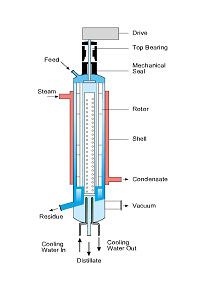08454-235236
give me a call
KEP’s short path evaporator is an alternative & economical solution for high vacuum distillation/ fractionation. KEP has developed short path evaporation technology with innovation and revelation at an optimized Capital & Operating Cost. Short path evaporation is a thermal separation technique that provides minimum pressure drop, permitting high vacuum operation down to 0.001 mbar. Short path evaporation is excellent for gently processing heat sensitive, high boiling products.

Suitable for viscous products.
Excellent turn down capability.
Low product holdup, good for hazardous materials.
Low power requirements.
Residence time of few seconds, important for heat sensitive products.
Operation pressure as low as 0.001 mbar (a). Hence production can be distilled at lower temperatures to avoid degradation.